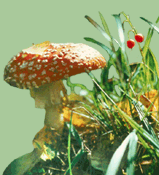Tree of the Year: Willow Tree, a versatile and useful species
Katrin Jürgens, Katrin Heinsoo and Andres Koppel introduce the possibilities to utilize willows as sources of energy and cleaners of the environment. In Estonian climate, willows are the best along with alder trees to be used in energy brush plantations. The two main used species are shrub-height Salix dasyclados and S. viminalis. The authors give advice on how to plant your own energy brush. The average biomass production from a willow plantation is about 12 m3/ha/year. One plantation lasts for about 25 years, during which 5-6 harvests can be derived. Willows are also known as cleaners of environment, since they take up large quantities of nutrients and water, including water-soluble pollutants.
Estonian Nature enquires
Olle Hints describes the current status of Estonian natural science collections.
Tiit Hunt sums up the results of the Bloodless Hunt of 2006.
Tree of the Year: Where do the Estonian largest willows grow?
Hendrik Relve, a specialist on old trees, observes old willow trees that at the age of 100 look bigger than centuries-old oak trees. Willows can grow very big, while being rather young in age. The author lists and describes the tallest and thickest willows of Estonia.
Tree of the Year: Willow is a young tree
Oive Tinn makes use of a long-term time-scale while introducing the short-age tree. In geological time-scale, the Family Saliccaeae is the youngest among the well-known and ordinary trees of Estonia: the oldest fossils are estimated to be 55-65 million years old. Based on geological findings, the willows most probably emerged in North Africa or in Asia.
The waves of fast ferries break the shores
Tarmo Soomere continues describing the dangerous sea waves, this time paying special attention to their influence on geological objects. The thorough article presents the mechanisms behind the genesis and effects of waves generated by fast ferry traffic. The effects of waves by fast ferries are short-time and cause very remarkable changes in the speed of water particles in certain depths. However, it is very difficult and expensive to study exactly how the artificial disturbance influences the shores. The deep erosions are revealed only by heavy storms, and after a storm it is very difficult to estimate the role of nature and the role of fast ferry traffic.
Manija landscape protection area
Urmas Vahur describes the small protected island in Pärnu County, where current landscape heritage and species diversity are being maintained despite of many hardships on the way. It is the kind of protected area where human activity should not be limited; vice versa, human activity and cattle raising is vitally important in order to restore and maintain the heritage landscapes typical to the area mostly the coastal meadows. There are currently 31 permanent residents on the island. One of the main objectives is to save the rare frog species the Natterjack Toad.
European rarities in Estonia: the Large Blue
Mati Martin seeks for answers to the question why this blue-winged butterfly with a strange lifestyle has not yet disappeared from Estonia. The Large Blue (Maculinea arion) is a small butterfly, but ranks the largest among blue-winged butterflies. It prefers sandy habitats and feeds mostly on Wild Thyme. The caterpillars of the Large Blue can develop only in ants nest, where it also spends the winter. The species is very sensitive to any changes in biotope and possible that is the reason why the Large Blue has become so rare all over Europe.
Interview: Botany is an interesting branch of science at all times.
Toomas Kukk has interviewed Anu Kalda, a botanist.
Hiking trail: A forest trail in Voorepalu kame field: kames, bog and a quarry
Helen Alumäe suggests the readers to visit one of the best-known recreation areas in South-Estonia the Kiidjärve-Taevaskoja recreation area formed by the Estonian State Forest Management Center. The Voorepalu forest trail includes hikes on kames, through the bog and around a quarry, altogether on 8 kilometres.
The rooibos tea is good to drink and good for health
Urmas Kokassaar speaks highly of the increasingly popular rooibos tea, which is actually derived from the leaves and branches of the red bush. The shrub called Red Bush originates from South Africa. The red bush tea has a calming effect, since it does not contain caffeine. However, it does contain antioxidants and many good microelements.
Two hundred years in the same location
A festive article by Hans Trass to mark the important 200th anniversary of the Botanical Garden of the University of Tartu. The garden is very small only 3,5 ha, but hosts thousands (6500) of different plant species, including some international rarities.
Wild boar
Sven Zaèek continues his photographical story series by introducing the habits of wild boar on photos and in text.
| 

![[IN ENGLISH]](images/gb.gif)





